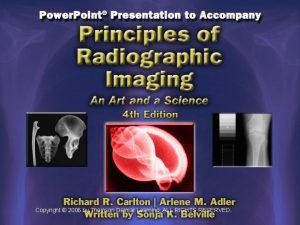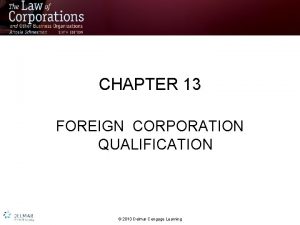Creating the Image Unit III 2013 Delmar Cengage






































- Slides: 38

Creating the Image Unit III © 2013 Delmar Cengage Learning. All Rights Reserved. May not be scanned, copied, duplicated, or posted to a publicly accessible website, in whole or in part.

Radiographic Film Chapter 19 © 2013 Delmar Cengage Learning. All Rights Reserved. May not be scanned, copied, duplicated, or posted to a publicly accessible website, in whole or in part.

Objectives • Describe components of radiographic film • Explain production of silver halide crystals • State purpose of various additives to radiographic film • Describe latent image formation © 2013 Delmar Cengage Learning. All Rights Reserved. May not be scanned, copied, duplicated, or posted to a publicly accessible website, in whole or in part.

Objectives • Discuss differences between direct exposure film, screen film, and films for various special applications, such as duplication • Explain the fundamentals of proper film storage and handling © 2013 Delmar Cengage Learning. All Rights Reserved. May not be scanned, copied, duplicated, or posted to a publicly accessible website, in whole or in part.

Objectives • Identify common radiographic film artifacts • Discuss automated and daylight loading film systems • Explain responsibilities involved in proper radiograph identification © 2013 Delmar Cengage Learning. All Rights Reserved. May not be scanned, copied, duplicated, or posted to a publicly accessible website, in whole or in part.

Photosensitive Film • First image receptor chosen by Röntgen • No longer most common image receptor because of predominance of digital imaging in 21 st century • Knowledge of film/screen technology still required of radiographers © 2013 Delmar Cengage Learning. All Rights Reserved. May not be scanned, copied, duplicated, or posted to a publicly accessible website, in whole or in part.

Radiographic Film Construction • Base • Adhesive layer • Emulsion • Supercoat (overcoat) © 2013 Delmar Cengage Learning. All Rights Reserved. May not be scanned, copied, duplicated, or posted to a publicly accessible website, in whole or in part.

Radiographic Film Base • Foundation of radiographic film – Flexible, yet durable – Uniformly radiolucent – Film must retain its size and shape throughout use and processing – Thickness ranges from 150 -200 micrometers – Modern base is thin sheet of polyester © 2013 Delmar Cengage Learning. All Rights Reserved. May not be scanned, copied, duplicated, or posted to a publicly accessible website, in whole or in part.

Base History • Original base: – Glass • Plates coated with emulsion – Difficult maintenance • Exposure factors with plates very high • Origin of term “flat plate” of abdomen © 2013 Delmar Cengage Learning. All Rights Reserved. May not be scanned, copied, duplicated, or posted to a publicly accessible website, in whole or in part.

Cellulose Nitrate • Replaced glass plates during World War I glass shortage • Highly flammable • Led to several devastating hospital fires in 1920 s and 1930 s © 2013 Delmar Cengage Learning. All Rights Reserved. May not be scanned, copied, duplicated, or posted to a publicly accessible website, in whole or in part.

Cellulose Triacetate • Safety base introduced in 1920 s – Less flammable than Cellulose Nitrate • Disadvantages: – Films would warp with age – Not as resilient as today’s polyester films © 2013 Delmar Cengage Learning. All Rights Reserved. May not be scanned, copied, duplicated, or posted to a publicly accessible website, in whole or in part.

Polyester • Base of today’s modern film • Introduced in 1960 s © 2013 Delmar Cengage Learning. All Rights Reserved. May not be scanned, copied, duplicated, or posted to a publicly accessible website, in whole or in part.

Specializations of Film Base • Blue tint – Reduces eyestrain – Increases diagnostic accuracy • Crossover – Light from one screen exposed opposite emulsion • Halation © 2013 Delmar Cengage Learning. All Rights Reserved. May not be scanned, copied, duplicated, or posted to a publicly accessible website, in whole or in part.

Cassette Loading • Single emulsion film – Emulsion side toward intensifying screen • Emulsion side dull • Non-emulsion side shiny – LL – notch in film in lower-left corner © 2013 Delmar Cengage Learning. All Rights Reserved. May not be scanned, copied, duplicated, or posted to a publicly accessible website, in whole or in part.

Adhesive Layer • Binds emulsion to film base – Allows for proper emulsion distribution over base throughout use and processing © 2013 Delmar Cengage Learning. All Rights Reserved. May not be scanned, copied, duplicated, or posted to a publicly accessible website, in whole or in part.

Emulsion • “Heart” of film • Composed of silver halide crystals suspended in gelatin – Active ingredient photosensitive • Silver halide crystals • Typically 5 -10 micrometers in thickness © 2013 Delmar Cengage Learning. All Rights Reserved. May not be scanned, copied, duplicated, or posted to a publicly accessible website, in whole or in part.

Gelatin • Allows even distribution – Separate suspension of silver halide crystals • • Radiolucent Non-reactive Processing chemistry able to penetrate Low Z# © 2013 Delmar Cengage Learning. All Rights Reserved. May not be scanned, copied, duplicated, or posted to a publicly accessible website, in whole or in part.

Types of Silver Halide Crystals • Silver bromide • Silver iodide • Silver chloride © 2013 Delmar Cengage Learning. All Rights Reserved. May not be scanned, copied, duplicated, or posted to a publicly accessible website, in whole or in part.

Duplitized Film • Double emulsion or double coated film © 2013 Delmar Cengage Learning. All Rights Reserved. May not be scanned, copied, duplicated, or posted to a publicly accessible website, in whole or in part.

Supercoat/Overcoat • Protective layer of gelatin – Provides sturdiness to unexposed radiographic film – Antistatic – Reduces damage from scratches, pressure, or contamination during storage, handling, and processing © 2013 Delmar Cengage Learning. All Rights Reserved. May not be scanned, copied, duplicated, or posted to a publicly accessible website, in whole or in part.

Manufacturing Radiographic Film • All must take place in total darkness: – Crystal production – Ripening – Mixing – Coating © 2013 Delmar Cengage Learning. All Rights Reserved. May not be scanned, copied, duplicated, or posted to a publicly accessible website, in whole or in part.

Silver Halide Crystal Formation • First step: – Pure metallic silver dissolved into nitric acid • Forms silver nitrate • Second step: – Silver nitrate combined with potassium bromide © 2013 Delmar Cengage Learning. All Rights Reserved. May not be scanned, copied, duplicated, or posted to a publicly accessible website, in whole or in part.

Silver Halide Crystal Formation • Combination yields silver bromide and potassium nitrate • Potassium nitrate is water soluble – Dissolves in water and washes away during production of emulsion © 2013 Delmar Cengage Learning. All Rights Reserved. May not be scanned, copied, duplicated, or posted to a publicly accessible website, in whole or in part.

Silver Halide Crystal Structure • Resultant shape can be many varying forms – However, inner structure takes on cubic form or cubic lattice © 2013 Delmar Cengage Learning. All Rights Reserved. May not be scanned, copied, duplicated, or posted to a publicly accessible website, in whole or in part.

Sensitivity Speck • Silver-gold-sulfide creates imperfections in crystals – Gives crystals good imaging properties – Result: • Sensitivity center or sensitivity speck within crystal lattice © 2013 Delmar Cengage Learning. All Rights Reserved. May not be scanned, copied, duplicated, or posted to a publicly accessible website, in whole or in part.

Sensitivity Speck • Allows for collection of many silver atoms in one area after being exposed to x-ray or light photons © 2013 Delmar Cengage Learning. All Rights Reserved. May not be scanned, copied, duplicated, or posted to a publicly accessible website, in whole or in part.

Ripening • Length of time crystals need to grow – Size and emulsion influence film factors • After ripening complete: – Emulsion cooled – Shredded and washed • Removes potassium nitrate © 2013 Delmar Cengage Learning. All Rights Reserved. May not be scanned, copied, duplicated, or posted to a publicly accessible website, in whole or in part.

Mixing • Shredded emulsion heated and melted – Specific temperature – Sensitizes crystals © 2013 Delmar Cengage Learning. All Rights Reserved. May not be scanned, copied, duplicated, or posted to a publicly accessible website, in whole or in part.

Mixing • Several extra ingredients may be added – Dyes • Adjust spectral sensitivity – Fungicide/bactericide – Antifogging agents © 2013 Delmar Cengage Learning. All Rights Reserved. May not be scanned, copied, duplicated, or posted to a publicly accessible website, in whole or in part.

Spectral Sensitivity • Panchromatic – Sensitive to all wavelengths • Orthochromatic – Not sensitive to red • Controlled by dyes added during mixing © 2013 Delmar Cengage Learning. All Rights Reserved. May not be scanned, copied, duplicated, or posted to a publicly accessible website, in whole or in part.

Coating • Requires precise and expensive equipment • Generates 40” rolls of film • Layers on adhesive, then emulsion, then supercoat • Film cut to size © 2013 Delmar Cengage Learning. All Rights Reserved. May not be scanned, copied, duplicated, or posted to a publicly accessible website, in whole or in part.

Latent Image Formation • Gurney-Mott Theory (1938) • X-ray and light photons deposit energy into silver halide crystals © 2013 Delmar Cengage Learning. All Rights Reserved. May not be scanned, copied, duplicated, or posted to a publicly accessible website, in whole or in part.

Latent Image Formation • Energy disrupts bonds between atoms of crystal – Electron freed – Halide migrates into gelatin – Silver ion remains © 2013 Delmar Cengage Learning. All Rights Reserved. May not be scanned, copied, duplicated, or posted to a publicly accessible website, in whole or in part.

Latent Image Formation • Sensitivity speck “traps” electron • Silver ion attracted to sensitivity speck to neutralize it • Process repeats itself © 2013 Delmar Cengage Learning. All Rights Reserved. May not be scanned, copied, duplicated, or posted to a publicly accessible website, in whole or in part.

Types of Film • Direct exposure (nonscreen) • Intensifying screen • Duplication © 2013 Delmar Cengage Learning. All Rights Reserved. May not be scanned, copied, duplicated, or posted to a publicly accessible website, in whole or in part.

Film Storage and Handling • Prior to exposure: – Storage • On end – Age • Expiration dates – Rotate stock – Heat • Below 68ºF (20ºC) © 2013 Delmar Cengage Learning. All Rights Reserved. May not be scanned, copied, duplicated, or posted to a publicly accessible website, in whole or in part.

Film Storage and Handling • Prior to exposure: – Humidity • 30 -60% – Light – Radiation © 2013 Delmar Cengage Learning. All Rights Reserved. May not be scanned, copied, duplicated, or posted to a publicly accessible website, in whole or in part.

Film Identification • Each exposure must include medical record information – Date of exposure – Full name of patient – Name of institution – Name of ordering physician – Patient identification number – Type of exam © 2013 Delmar Cengage Learning. All Rights Reserved. May not be scanned, copied, duplicated, or posted to a publicly accessible website, in whole or in part.
 Delmar cengage learning medical terminology
Delmar cengage learning medical terminology 2009 delmar cengage learning
2009 delmar cengage learning 2009 delmar cengage learning
2009 delmar cengage learning 2009 delmar cengage learning
2009 delmar cengage learning 2009 delmar cengage learning
2009 delmar cengage learning Chapter 13 medical math assignment sheet cengage learning
Chapter 13 medical math assignment sheet cengage learning Chapter 10 cultural diversity
Chapter 10 cultural diversity Delmar cengage learning instructor resources
Delmar cengage learning instructor resources Word module 2 creating a research paper
Word module 2 creating a research paper Training evaluation
Training evaluation Hamlet act iii scene iii
Hamlet act iii scene iii Delmar isotonic
Delmar isotonic Delmar tsi
Delmar tsi Delmar cargo
Delmar cargo Delmar thomson learning
Delmar thomson learning Borgify
Borgify Histogram equalization
Histogram equalization Unit 10, unit 10 review tests, unit 10 general test
Unit 10, unit 10 review tests, unit 10 general test Pharyngorrhea
Pharyngorrhea Cengage differential equations
Cengage differential equations Bank reconciliation cengage
Bank reconciliation cengage Separation of variables differential equations
Separation of variables differential equations Cengage chapter 7
Cengage chapter 7 Cengage chapter 5
Cengage chapter 5 Cengage learning heart diagram
Cengage learning heart diagram Cengage
Cengage Cengage
Cengage Cengage
Cengage South-western cengage learning
South-western cengage learning Cengage
Cengage Cengage
Cengage Mongols
Mongols Cengage learning heart diagram
Cengage learning heart diagram Cengage accounting chapter 13 test answers
Cengage accounting chapter 13 test answers Cengage learning australia
Cengage learning australia Whille
Whille Cengage learning
Cengage learning Module 5 computer concepts exam answers
Module 5 computer concepts exam answers Cengage
Cengage




























































